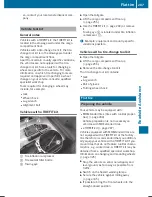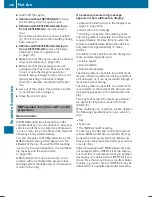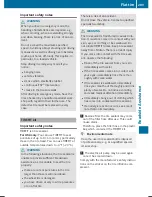
G
WARNING
During the charging process, a battery produces hydrogen gas. If a short circuit occurs or
sparks are created, the hydrogen gas can ignite. There is a risk of an explosion.
R
Make sure that the positive terminal of a connected battery does not come into contact with
vehicle parts.
R
Never place metal objects or tools on a battery.
R
It is important that you observe the described order of the battery terminals when connect-
ing and disconnecting a battery.
R
When jump-starting, make sure that the battery poles with identical polarity are connected.
R
It is particularly important to observe the described order when connecting and disconnect-
ing the jumper cables.
R
Never connect or disconnect the battery terminals while the engine is running.
G
WARNING
A discharged battery can freeze at temperatures below freezing point. When jump-starting the
vehicle or charging the battery, gases can escape from the battery. There is a risk of an explo-
sion.
Allow the frozen battery to thaw out before charging it or jump-starting.
!
Avoid repeated and lengthy starting attempts. Otherwise, the catalytic converter could be
damaged by the non-combusted fuel.
If the indicator/warning lamps do not light up in the instrument cluster at low temperatures, it is
very likely that the discharged battery has frozen. In this case you may neither jump-start the
vehicle nor charge the battery. Let the battery thaw first. The service life of a thawed-out battery
may be shorter. The starting characteristics can be impaired, particularly at low temperatures.
Have the thawed-out battery checked at a qualified specialist workshop.
Do not start the vehicle using a rapid charging device. If your vehicle's battery is discharged, the
engine can be jump-started from another vehicle or from a second battery using jumper cables.
Observe the following points:
R
The battery is not accessible in all vehicles. If the other vehicle's battery is not accessible,
jump-start the vehicle using a second battery or a jump-starting device.
R
You may only jump-start the vehicle when the engine and exhaust system are cold.
R
Do not start the engine if the battery is frozen. Let the battery thaw first.
R
Only jump-start from batteries with a 12 V voltage rating.
R
Only use jumper cables that are not damaged and have a sufficient cross-section and insula-
ted terminal clamps.
R
Make sure that the two vehicles do not touch.
Make sure that:
R
The jumper cables are not damaged.
R
Non-insulated parts of the terminal clamps do not come into contact with other metal parts
while the jumper cables are connected to the battery.
R
The jumper cables cannot come into contact with parts that can move when the engine is run-
ning, such as the V-belt pulley or the fan.
X
Secure the vehicle by applying the electric parking brake.
X
Shift the transmission to position
j
.
X
Turn the SmartKey to position
g
in the ignition lock and remove it.
296
Jump-starting
Roadside
As
sis
tance
















































